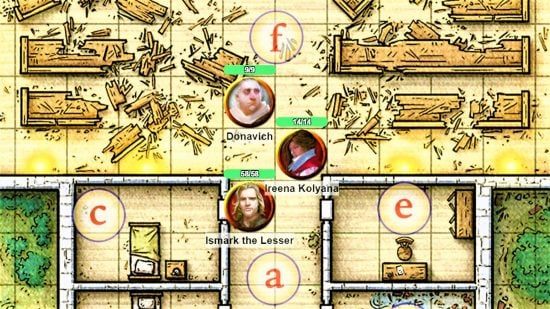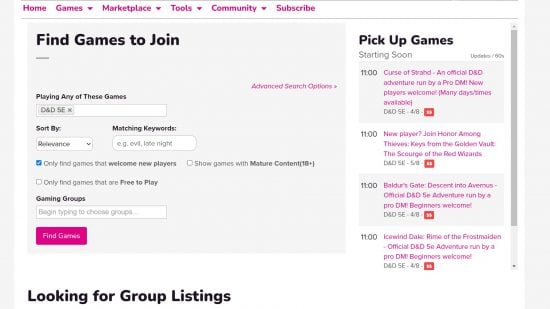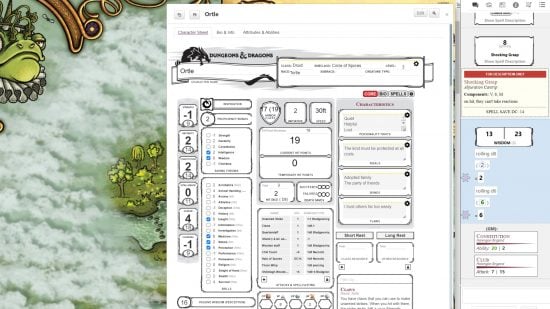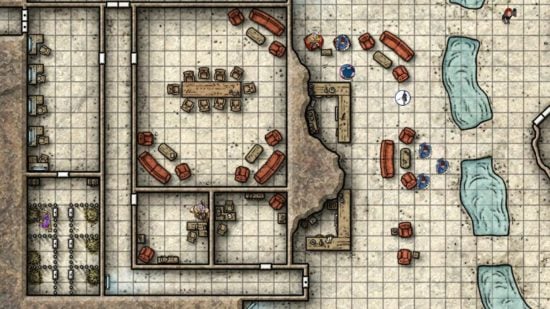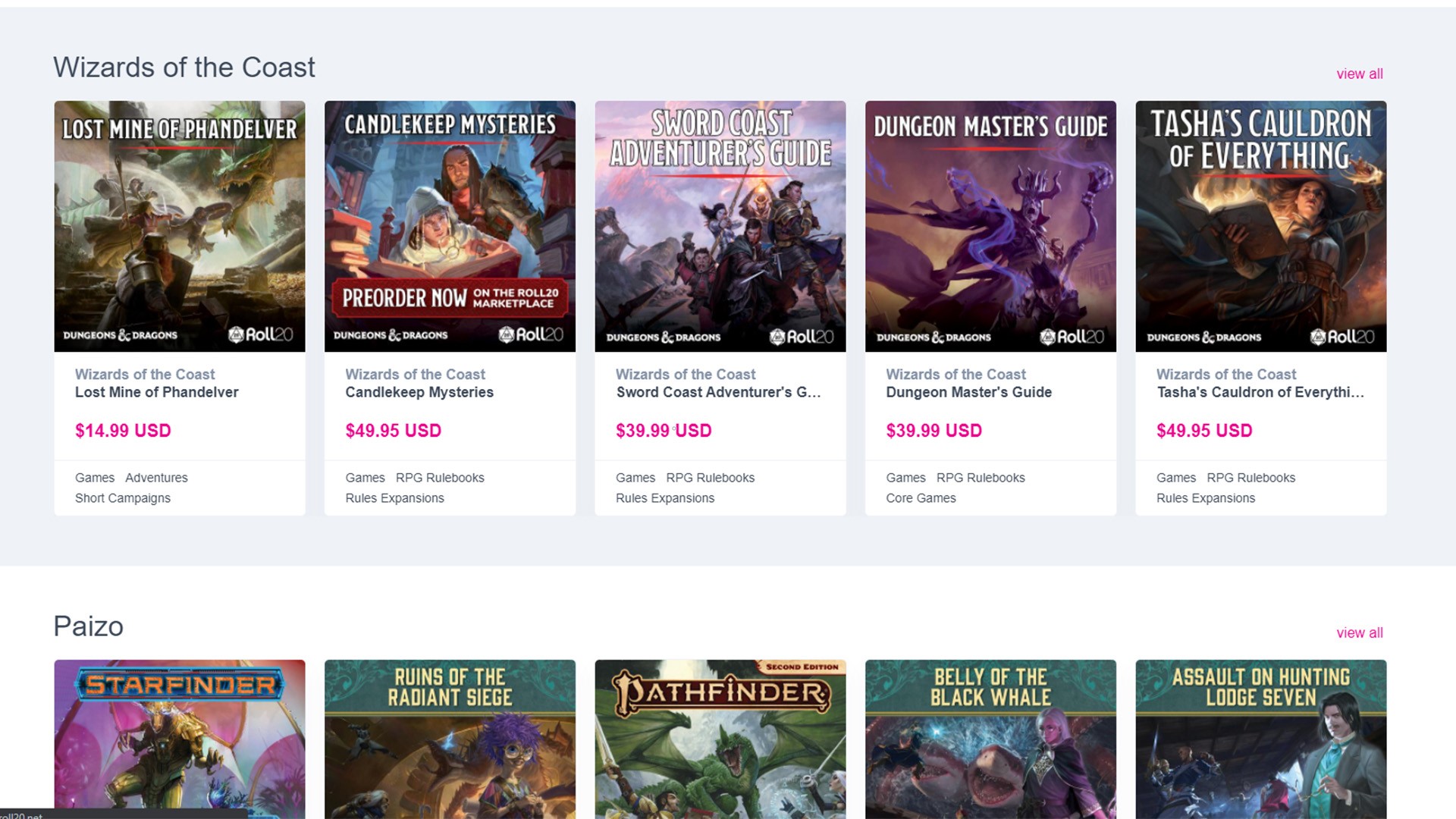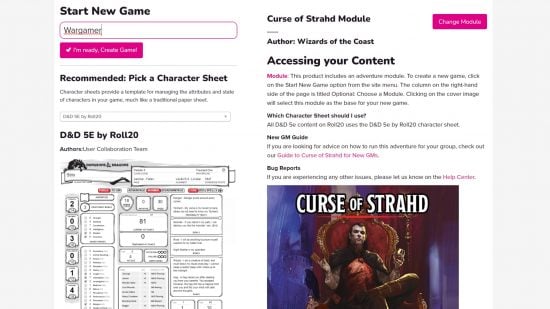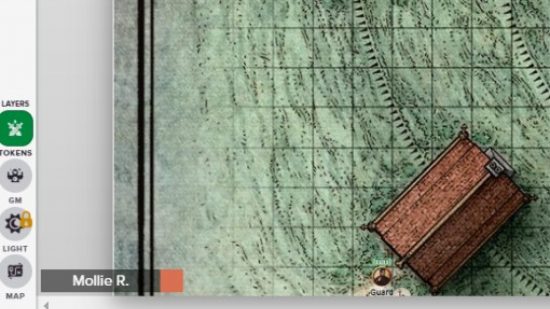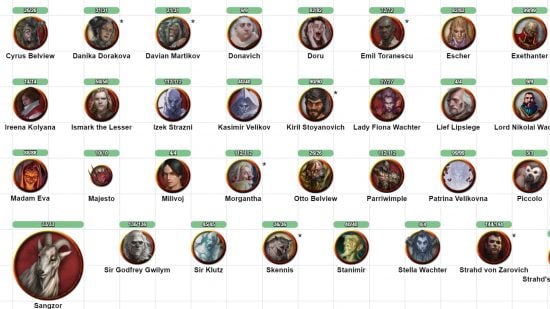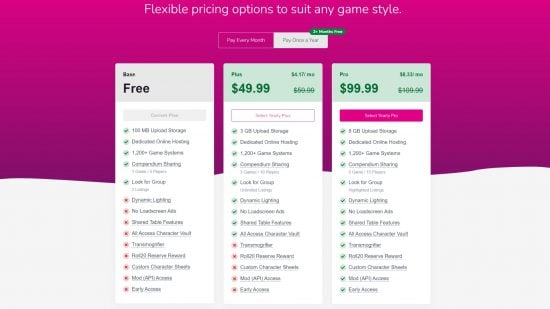Roll20, and other virtual tabletop RPG platforms like it, lets you to go on dice-rolling adventures with your friends from the comfort of your own home. Taking your roleplaying sessions online, you can play Dungeons and Dragons or Pathfinder wherever you are, and whatever the situation. It’s not so simple to learn, though – so here’s our comprehensive Roll20 tutorial.
One of the best-known virtual tabletops, Roll20 gives you everything you need to run a roleplaying adventure with your mates, in your browser, for free. Offering tons of neat features – and receiving support from Wizards of the Coast, Paizo, and other major publishers – it has a whole range of new and classic campaigns that have been optimized for playing digitally. It’s also got a flexible suite of tools that let you automate your own DnD character sheets and build your own DnD campaigns from scratch.
However, even once you’ve learned how to play Dungeons and Dragons, making the step from pen-and-paper to the digital tabletop is a big deal, and the mere thought of starting an online campaign can be as frightening as a tyrannical Dungeon Master.
We’ll get you started playing D&D and other tabletop RPGs with the free version of Roll20, offering essential step-by-step guidance and tips to make sure your first session is as stress-free and devoid of technical troubles as humanly, elvenly, or even dwarvenly possible.
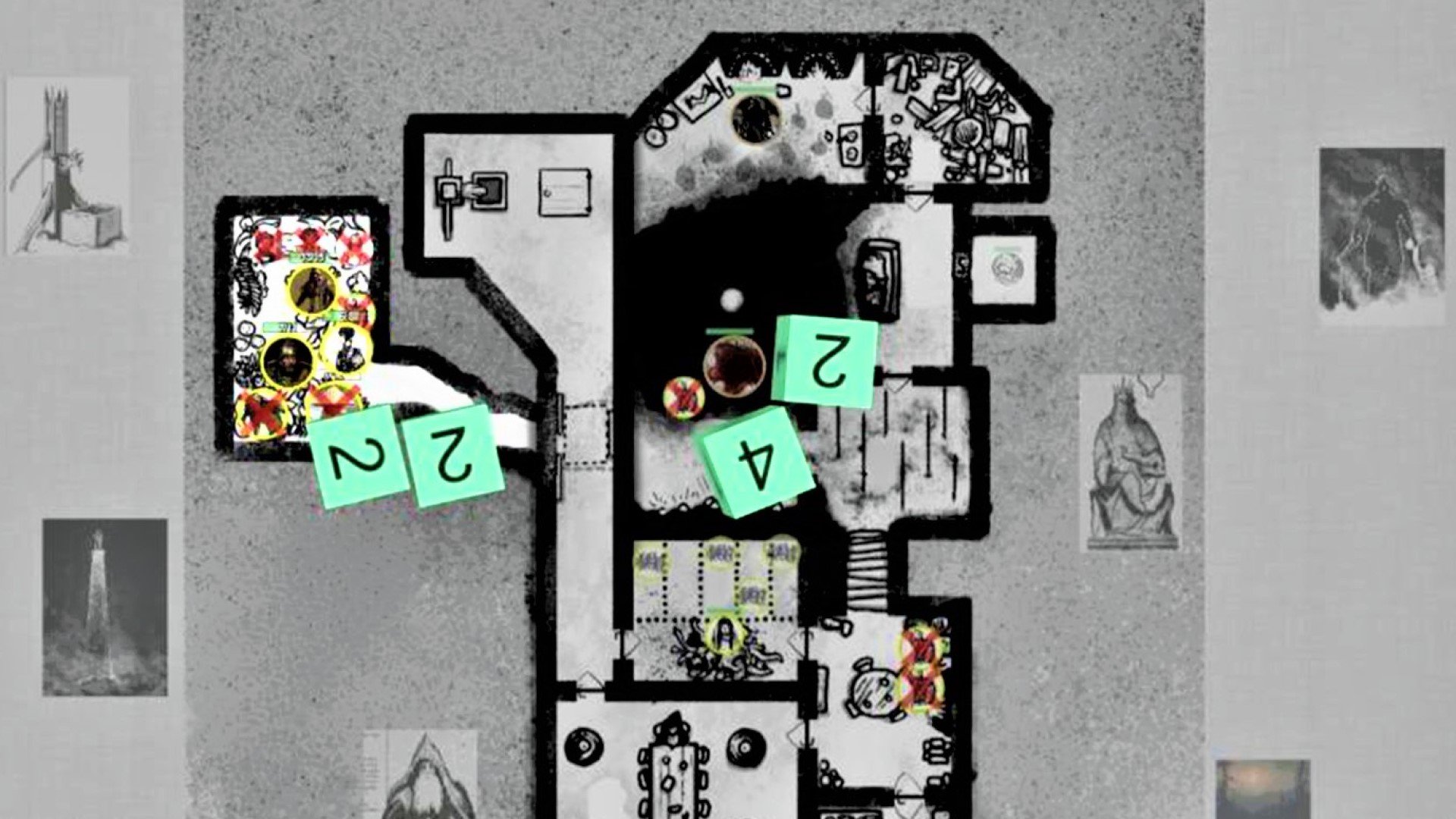
Here’s a complete Roll20 player tutorial:
And here’s a Roll20 GM tutorial:

Joining a Roll20 game
If you’re playing a game on Roll20 for the first time, you’ll need to create a Roll20 account before you do anything else. You can do this for free in your browser, without the need to download or pay for anything.
While we’re here, let’s talk about browsers – as Roll20 definitely works better in some than others. Chrome and Firefox are recommended as the go-to browsers as they’re officially supported by Roll20.
This means you can run things in Microsoft Edge, but there’s less first-party support if things go wrong. And as for Safari – best to stay clear.
With your browser chosen and your account set up, you’ll next need to find a game. If you joined Roll20 with a specific campaign in mind, you may have been sent a hyperlink to join your GM’s campaign. They may instead ask for the email address attached to your Roll20 account so they can invite you manually.
If you’re currently GM-less, you can also find public games looking for players. Simply hover over the ‘games’ tab in the toolbar, select ‘join a game’, and start browsing. Each listing provides details of what system the game uses, the number of players the game supports, what language the game is played in, whether you need to pay to play, and more.
As well as a Roll20 account, it helps to be signed up to a separate application for audio and video calls (we highly recommend Discord). Roll20’s software for these isn’t great quality, so it’s better to keep the Roll20 audio and video permissions off.
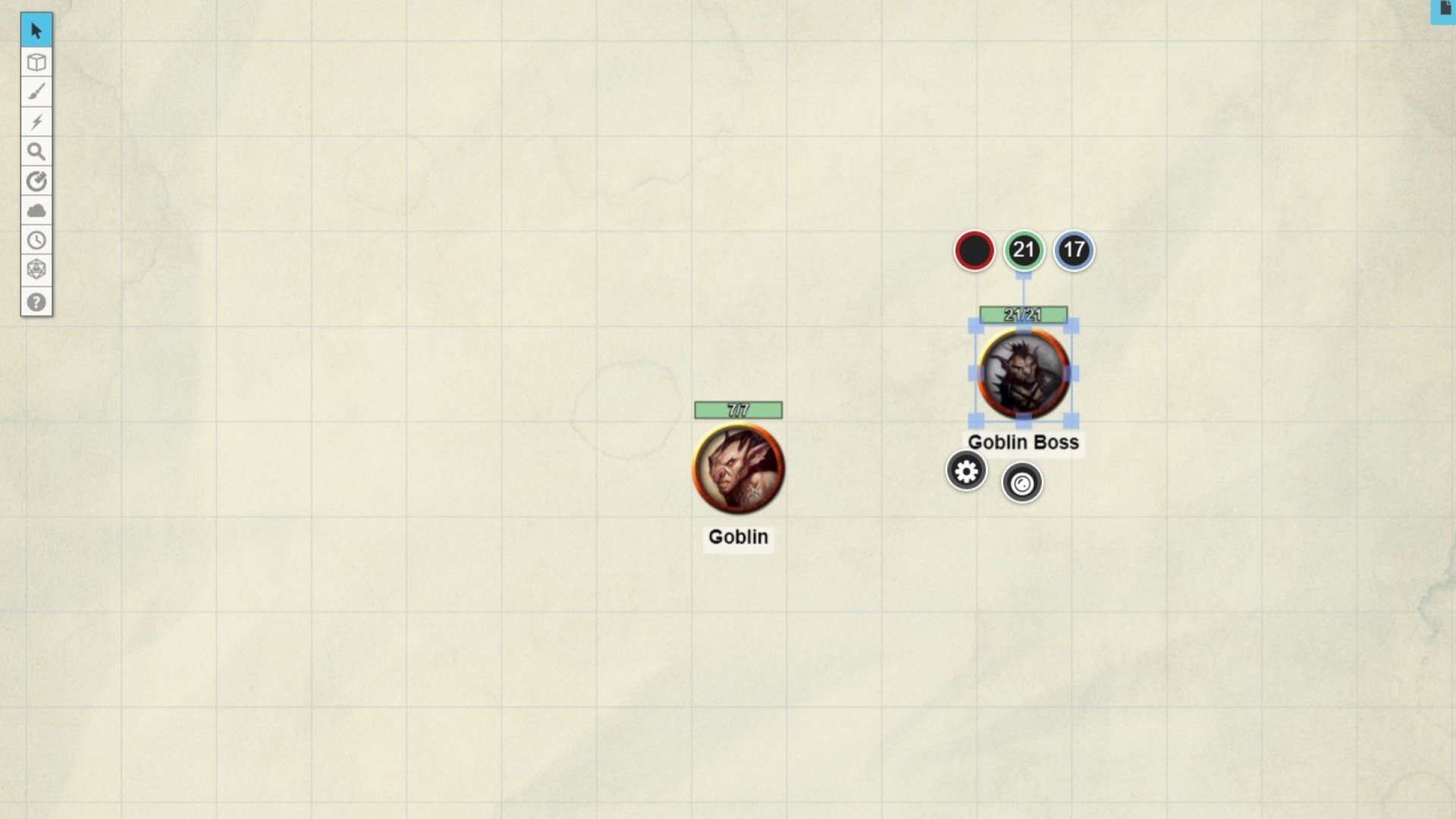
Roll20 character sheets and tokens
Congratulations! You’ve just joined your first Roll20 game. Let’s talk about the tools you’ll need to create and play a character.
Character sheets
When you’ve launched a game, all details about your character can be found in the ‘journal’ tab on the right (the icon that looks like a book). Here you should find a character sheet assigned to you. The GM will have chosen a specific system for the campaign, and Roll20 often provides the appropriate kind of character sheet.
Character sheets are fully editable and automated – meaning, when filled out, it calculates a lot of stats and dice rolls for you. Let’s look at a DnD character sheet to show you what we mean.
You can type your stats manually into the boxes on the left of the sheet, and your ability score modifiers will automatically be calculated. Once you’ve chosen your class from the drop-down at the top, features like your Hit Dice and proficiency bonus will be automatically updated with any DnD level up.
You can also automate your spells and weapon attacks, but this takes a little more fiddling. Many boxes on the character sheet have a plus sign in them, which allows you to add items to a list. Here you fill in all the details of your weapon or spell – for example, the damage calculation – so Roll20 can automatically do the math any time you click on that item.
It can take a bit of work to get right (for example, you have to turn your spells’ output to ‘attack’ if you want them to show up in the ‘attacks and spellcasting’ part of your sheet). However, with a bit of practice, it becomes pretty intuitive.
Playing with D&DBeyond
If you’re playing D&D, you might already have a character sheet uploaded to D&DBeyond. It is possible to play with this character sheet without having to manually duplicate the information in Roll20. We recommend the Beyond20 browser extension, which links your campaign to D&DBeyond.
Here’s a quick tutorial on how to set up Beyond20:

Tokens
While an in-person RPG game may use DnD miniatures, Roll20 uses tokens to represent players and DnD monsters. Your GM should have assigned you permission to move and create a token that represents you (for GMs, more on making these later).
If you want to place your character token on a map, go to your journal and find your character sheet. Don’t open it – instead, hover over your character’s name, click and hold, and drag it onto the main play area. This should create a new copy of your token, which can be moved around at your leisure.
If you click on your token, several buttons will appear. The three colored circles above your token can be used to enter numbers – this can help you track things like current HP and armor class without having to open your character sheet. The wheel cog below controls the token’s settings (leave that to your GM for now), and the last button allows you to add symbols to the token to represent various conditions.
Roll20 basic controls
When you’re not interacting with your character sheet, you’ll be moving your token around the GM’s chosen maps and interacting with the world they’ve created. As a player, there aren’t too many basic controls you’ll need to do this.
Clicking can get you a long way. Click and drag a token under your control to place it somewhere on the map, for example. Plus, if you click and hold your cursor on a certain part of the map, Roll20 creates an animation to show other players you want to highlight this location.
For most other things, head to the vertical toolbar on the left side of the screen. First up, you have the ‘Select’ and ‘Pan’ buttons, which help you scroll around the map and move your tokens (by clicking and dragging, as we already explained).
One of the toolbar’s buttons is shaped like a paintbrush, and you can use it to draw on the map – click on it, and you’ll have options to create shapes or lines. The ‘T’ below lets you add text, too. If your GM ever finds these scribbles too distracting, they also have a button that lets them clear all the drawings.
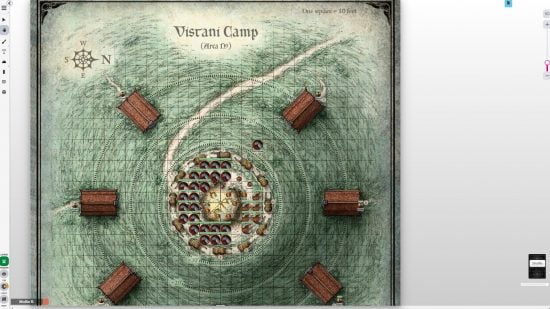
You can also zoom in and out with a slider on the right side of the screen, next to the chat. The ruler in the toolbar can be used for measurements, which is particularly useful for calculating the range of a spell. To use it, simply click on the ruler in the toolbar, then click and drag on the map.
Finally, there’s the d20 symbol in the toolbar, which allows you to roll certain RPG dice. Simply hover and select the type of die and the amount you want to roll – you can also use the chat box on the right to roll by typing “r/roll [NUMBER][DICE]”. For example, “r/roll 20d20” will do just that.
You’ll notice a few more icons in the left-hand toolbar that we haven’t talked about. First is the cloud-shaped icon that’s titled ‘Fog of War’. This is a tool for GM’s to help conceal and reveal different parts of the map. We recommend newbie GMs leave this feature alone until they’re more familiar with Roll20 in general – we’ll update this guide with a full Fog of War tutorial at a later date, too.
The last icon to discuss looks like a tiny sword in front of some lines. This is the ‘turn order’ button, and we’ll explain it in more detail later on, when we come to tips for Roll20 GMs.
Creating a Roll20 game
Creating a Roll20 game is as simple as selecting ‘create new game’ from the ‘games’ drop-down. Simply name your game, and you’re ready to go!
For new DMs, we highly recommend starting with one of Roll20’s existing adventure modules. Learning how to build a Roll20 game from scratch is a whole other tutorial in itself – and not something we’d recommend for first-timers. For a pretty reasonable price, a Roll20 module provides high-quality maps and tokens, and it does all the hard setup work for you.
The final decision you need to make at this stage is what system character sheet you want to tie to your game. We highly recommend using the allocated character sheet for your system if there’s one available – it can help with all the character sheet automation we mentioned above.
Congratulations, you’ve just created your first Roll20 game! Now’s a good time to hop into your game’s settings and tweak things to your liking. There are a lot of things you can change, but here are a few suggestions:
- Set ‘Roll Queries’ to ‘Always Roll Advantage’ so players never need to double roll.
- Use ‘whisper rolls’ to decide whether you want players to be able to see each other’s rolls.
- Turn on ‘Auto Damage Roll’ and ‘Add Dex Tiebreaker to Initiative’ to save your group time during combat.
- Decide whether you want to track more fiddly details like encumbrance and ammo.
- Charactermancer is a helpful Roll20 feature that helps you with the character creation process – it’s important to decide whether you want it on or off before a game starts as it’ll affect leveling up.
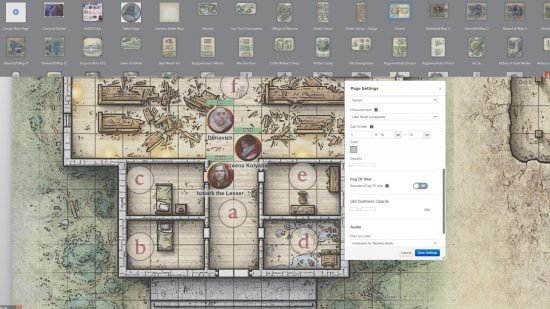
Roll20 pages, layers, and tokens
Your Roll20 game will take place on multiple pages, and each page is split into different layers. Most pages will represent different DnD maps, upon which you’ll place tokens. Let’s take a look at how to use all of these.
Pages
Firstly, pages. There’s a blue button at the top of your screen which opens the page toolbar. As a GM, you can click through these and privately view different pages – or you can move players to a new page by clicking and dragging the red ‘players’ ribbon which appears over the top of the currently-viewed page.
If you’re using a pre-made module, all the pages you need will likely be set up (though if you want a few extra maps, we’d recommend uploading ones you create with these DnD map makers). However, you can create a blank page with the ‘create new page’ button at the very start of your list of pages. Click on the settings for a new page, and you can adjust all sorts of details like how much space each square represents or how opaque your secret DM layer will be.
Here you can also add music to a specific page. You’ll first need some songs in your Roll20 jukebox – you can find these by clicking on the right-hand tab button that looks like a musical note, clicking ‘manage audio’, and hitting ‘add to game’ on any pre-generated tracks you like the sound of. Then, in your page settings, you can select a track to ‘play on load’ when players enter a map.
Layers
Each page has three layers you should focus on: ‘Map’, ‘Tokens’, and ‘GM Layer’. These names are pretty self-explanatory. Your map sits on the first layer, not to be tampered with; the tokens you want players to see and move go on the second layer; and tokens, notes, and other features you want to remain hidden stay on your GM layer.
You can switch layers by clicking the relevant layer icon in the bottom-left part of the screen. Or, you can use these command keys:
- Ctrl + M – Move to map layer
- Ctrl + O – Move to objects layer
- Ctrl + K – Move to GM layer
If you click on a token and hold Shift while you press these hot keys, you can also automatically move a token from one layer to the next.
Tokens
Speaking of tokens, you should have plenty of pre-made ones to choose from in your Roll20 journal. If you’d like to make some of your own, you can easily do so for free with websites like Token Stamp and VTT Token Maker.
It helps to connect players’ character tokens to their character sheet before your game begins. You can do this in the token’s settings – here’s a quick video tutorial on how to do that:

Make sure to assign control of that token to the right player, too – they’ll need that to move it around your maps.
We already talked about token features in the player section of this tutorial, but there’s one more thing a GM should know about them. This is that they can be added to Roll20’s turn tracker any time you want to call out ‘roll for initiative’.
The left-hand toolbar has a button that looks like a clock. Click this, and you’ll open a turn tracker to record initiative rolls. If you’re playing a D&D game with built-in character sheets, players can roll initiative by clicking on their player token, then hitting ‘initiative’ on their Roll20 character sheet.
For NPCs and anyone not using a character sheet, simply perform a regular roll in the Roll20 chat. Then right-click the chosen token, select ‘add turn’, and manually type in your result on the turn tracker. (You can use Roll20 macros to automate this, but we’d recommend looking into those when you’re a bit more experienced.)
Roll20 subscription
When you’re more experienced running games on Roll20, you may decide to check out a Roll20 subscription. A monthly or yearly payment grants you access to extra features.
Roll20 Plus
| Monthly price | $5.99 (£4.71) |
| Yearly price | $49.99 (£39.30) |
Roll20 Plus gives subscribers 3GB of upload storage rather than 100MB, which means more storage for your campaigns. It also removes ads and allows you to transfer an unlimited number of characters between games. Plus, you can share these features with players who sign up to your games.
Perhaps the biggest change at this subscription level is the introduction of dynamic lighting. This tool allows GMs to hide areas of a map that are beyond their player’s line of sight. The video below shows you how the latest version of dynamic lighting works:

Roll20 Pro
| Monthly price | $9.99 (£7.85) |
| Yearly price | $99.99 (£78.61) |
Roll20 Pro includes all the features of Roll20 Plus, as well as a few extras. 3GB of storage becomes 8GB, and Roll20 rewards your commitment with early access to new features and a curated, monthly collection of assets for your games. You and your players can also customize your character sheets.
Additionally, it becomes possible to copy elements like pages and handouts between games, and you can access community-created API scripts that offer detailed ways to customize your game. This is the height of complexity on Roll20, so if you’re still a beginner, you likely won’t need this option until later in your online GM-ing career.
That’s your comprehensive beginner’s tutorial for Roll20 finished! If you need any other help setting up a DnD campaign, here are even more resources from us at Wargamer. We can recommend everything from the best DnD books to the most useful DnD character creators.
